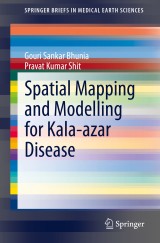Details

Spatial Mapping and Modelling for Kala-azar Disease
SpringerBriefs in Medical Earth Sciences
|
53,49 € |
|
| Verlag: | Springer |
| Format: | |
| Veröffentl.: | 07.04.2020 |
| ISBN/EAN: | 9783030412272 |
| Sprache: | englisch |
Dieses eBook enthält ein Wasserzeichen.
Beschreibungen
This book addresses the current challenges in controlling Kala-azar disease (<i>Visceral leishmaniasis</i>) in India and other VL-endemic areas, and aims to develop and apply a geo-environmental risk model based on primary and secondary data with the aid of remote sensing and GIS technologies to assess and mitigate Kala-azar transmission. Through case studies carried out in India, the book provides insight into the relationship between geo-environmental variables and encroachments of Kala-azar, and identifies potential pathways for VL introduction to develop mitigation strategies using GIS and remote sensing technologies. The book critically assesses existing VL mitigation measures that do not adequately account for geo-environmental conditions, and analyzes the environmental factors that aid Kala-azar transmission using remote sensing, spatial statistics and data mining techniques. The book will be of interest to epidemiologists, researchers and practitioners using geospatial data practices to study disease transmission and associated monitoring technologies.
Chapter 1.- Introduction of Kala.- azar. Chapter 2.- Role of Geoinformatics of Kala.- azar Disease Assessment. Chapter 3.- Micro.- geographical factors of Kala.- azar. Chapter 4.- Open Source GIS and Kala.- azar Transmission. Chapter 5.- Vector Ecology of Kala.- azar Transmission. Chapter 6.- Disease Ecology and Transmission. Chapter 7.- Appraisal of existing measure and future control strategy for Kala-azar.
<p>Gouri Sankar Bhunia received his Ph.D. from the University of Calcutta, India in 2015. His Ph.D. dissertation work focused on environmental control measures of infectious disease (Visceral leishmaniasis or kala-azar) using Geospatial technology. His research interests include Kala-azar disease transmission modeling, environmental modelling, risk assessment, data mining and information retrieval using Geospatial technology. Dr. Bhunia is associate editor and on the editorial boards of three international journals in Health GIS and Geosciences. He is a recipient of the Senior Research Fellow (SRF) from Rajendra Memorial Research Institute of Medical Sciences (ICMR, India) and contributed to multiple research programs Kala-azar disease transmission modelling, development of Customized GIS software for Kala-azar “risk” and “non-risk” area and entomological study. </p>
Pravat Kumar Shit received his Ph.D. in Geography (Applied Geomorphology) from Vidyasagar University (India) in 2013, M.Sc. in Geography and Environment Management from Vidyasagar University in 2005 and PG Diploma in Remote Sensig & GIS from Sambalpur University in 2015. He is an Assistant Professor in the Department of Geography, Raja N. L. Khan Women’s College (Autonomus), Gope Palace, Midnapore, West Bengal, India. His main fields of research are soil erosion spatial modeling, badland geomorphology, gully morphology, water resources and natural resources mapping and modeling. His research work has been funded by the University Grants Commission (UGC), India. Dr. Shit is associate editor and on the editorial boards of three international journals in geography, and earth environment science.<p></p>
Pravat Kumar Shit received his Ph.D. in Geography (Applied Geomorphology) from Vidyasagar University (India) in 2013, M.Sc. in Geography and Environment Management from Vidyasagar University in 2005 and PG Diploma in Remote Sensig & GIS from Sambalpur University in 2015. He is an Assistant Professor in the Department of Geography, Raja N. L. Khan Women’s College (Autonomus), Gope Palace, Midnapore, West Bengal, India. His main fields of research are soil erosion spatial modeling, badland geomorphology, gully morphology, water resources and natural resources mapping and modeling. His research work has been funded by the University Grants Commission (UGC), India. Dr. Shit is associate editor and on the editorial boards of three international journals in geography, and earth environment science.<p></p>
This book addresses the current challenges in controlling Kala-azar disease (<i>Visceral leishmaniasis</i>) in India and other VL-endemic areas, and aims to develop and apply a geo-environmental risk model based on primary and secondary data with the aid of remote sensing and GIS technologies to assess and mitigate Kala-azar transmission. Through case studies carried out in India, the book provides insight into the relationship between geo-environmental variables and encroachments of Kala-azar, and identifies potential pathways for VL introduction to develop mitigation strategies using GIS and remote sensing technologies. The book critically assesses existing VL mitigation measures that do not adequately account for geo-environmental conditions, and analyzes the environmental factors that aid Kala-azar transmission using remote sensing, spatial statistics and data mining techniques. The book will be of interest to epidemiologists, researchers and practitioners using geospatial data practices to study disease transmission and associated monitoring technologies.
Discusses the measurement, modeling and mapping of Kala-azar disease transmission Covers the use of spatial analysis techniques in vector-borne disease through open source software Describes sustainable disease control strategies and remediation techniques through case studies
Diese Produkte könnten Sie auch interessieren:

Observing Systems for Atmospheric Composition

von: Guido Visconti, Pietro Di Carlo, W. Brune, M. Schoeberl, Andreas Wahner

149,79 €















